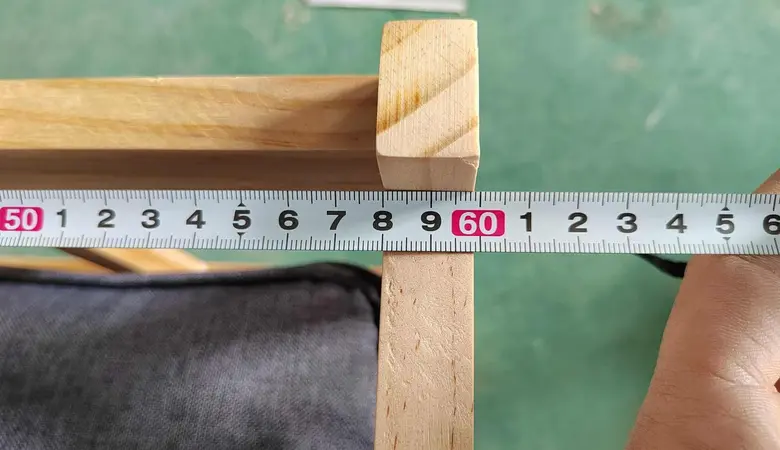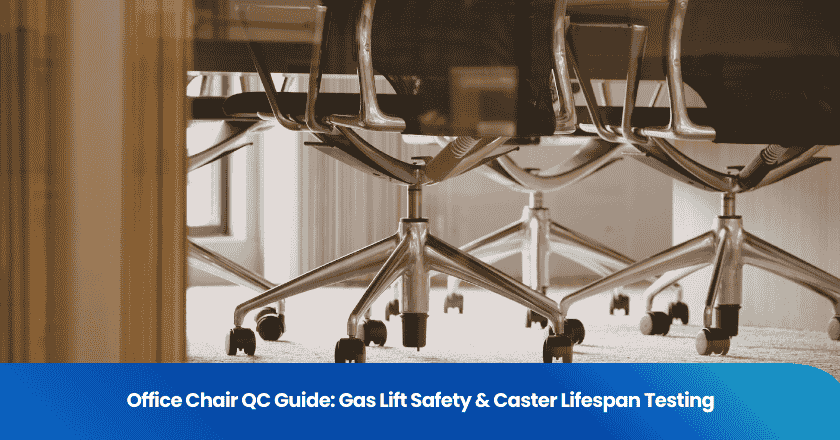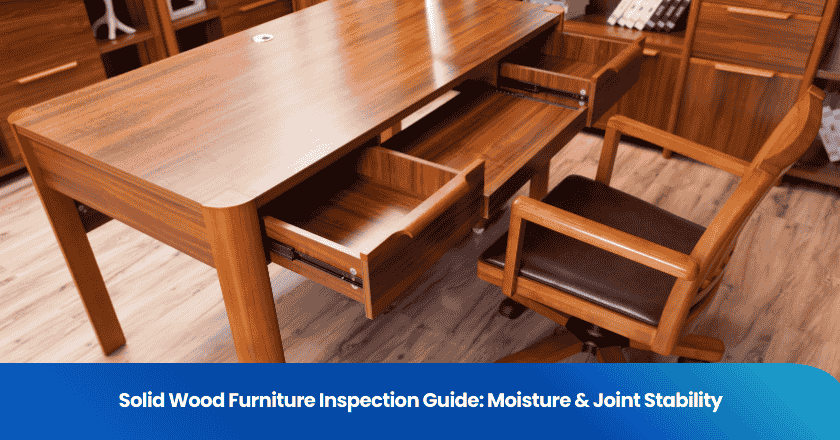
Key Takeaways
• Use a detailed checklist to inspect materials, structure, finish, safety features, dimensions, and packaging for consistent quality.
• Regular inspections catch defects early, save costs, and protect your brand’s reputation by ensuring safety and compliance.
• Stay updated with 2025 standards that emphasize durability, safety, sustainability, and digital record-keeping for better traceability.
• Choose inspection partners who offer clear communication, reliable reporting, and expertise in current regulations and testing methods.
• Conduct inspections at key stages: before production, during assembly, and before shipment to maintain high-quality furniture.
Why Inspection Matters
Safety and Compliance
Furniture quality inspection plays a crucial role in ensuring safety and compliance. Inspectors check every piece of furniture for hazards, such as sharp edges or unstable structures. They verify that each product meets the latest compliance requirements. Quality control inspection teams look for potential risks that could harm users. They also confirm that all materials and components follow safety standards. Inspections help manufacturers avoid costly recalls by identifying issues early. Compliance with regulations protects both buyers and sellers from legal problems. Regular quality control inspection ensures that every item meets strict safety guidelines.
Note: Consistent quality inspection helps companies maintain compliance and avoid penalties.
Cost and Reputation
Quality control inspection directly affects the cost and reputation of any furniture business. When inspections catch defects early, companies save money on repairs and replacements. Quality inspection teams help reduce waste by identifying problems before products reach customers. Inspections also protect a brand’s reputation by ensuring only high-quality furniture enters the market. Buyers trust companies that prioritize quality control and compliance. Poor quality or failed compliance can lead to negative reviews and lost sales. Regular inspections support long-term business growth by building customer confidence. Companies that invest in quality control inspection often see fewer returns and higher customer satisfaction.
• Inspections lower costs by preventing expensive mistakes.
• Quality control inspection builds trust with buyers and partners.
• Compliance with regulations strengthens a company’s market position.
Furniture Quality Inspection Checklist
Materials and Components
A comprehensive furniture quality inspection checklist begins with a close review of all materials and components. Inspectors examine wood, metal, plastic, and upholstery for consistency and durability. They check for warping, cracks, or visible defects. Both manufacturers and buyers should confirm that all materials meet current durability standards and pass environmental testing. Inspectors verify that adhesives and fasteners hold under stress. They also ensure that all hardware resists corrosion and functions as intended. The inspection checklist includes tests for moisture content in wood and checks for harmful chemicals in finishes. Quality control inspection teams document any irregularities and recommend corrective actions.
Tip: Always request documentation for material sourcing and test results during quality inspection.
Structural Integrity
Structural integrity stands at the core of every quality inspection checklist. Inspectors perform load-bearing tests and assess the stability of joints and frames. They apply pressure to key points to confirm that the furniture does not wobble or collapse. Quality control inspection teams look for loose screws, weak welds, and gaps in construction. Both buyers and manufacturers should require structural and safety tests to guarantee long-term performance. The inspection checklist covers repeated use simulations to ensure the furniture maintains its integrity over time. Inspectors also check for proper reinforcement in high-stress areas.
• Inspect all joints for tightness and alignment.
• Test frames for resistance to bending and twisting.
• Confirm that all fasteners remain secure after repeated use.
Appearance and Finish
The appearance and finish of furniture play a significant role in customer satisfaction. Inspectors use the quality inspection checklist to review all surfaces for scratches, dents, or uneven coatings. They check for color consistency and smoothness across every visible area. Quality control inspection teams verify that finishes resist stains and fading under normal use. Both buyers and manufacturers should expect uniform paint or varnish application. The inspection includes close examination of decorative elements and trim. Inspectors note any blemishes or imperfections that could affect the product’s appeal.
Note: High-quality finishes protect furniture from daily wear and environmental exposure.
Safety Features
Safety remains a top priority in every furniture quality inspection. Inspectors check for sharp edges, pinch points, and exposed hardware. The inspection checklist requires verification of anti-tip devices, locking mechanisms, and child safety features. Quality control inspection teams test for stability on uneven surfaces. They confirm that all moving parts operate smoothly and safely. Both buyers and manufacturers must ensure compliance with updated safety standards. Inspectors also review warning labels and instructions for clarity and accuracy.
• Confirm all safety features function as designed.
• Check for compliance with the latest safety regulations.
• Inspect for proper installation of protective components.
Dimensions and Functionality
Accurate dimensions and reliable functionality form essential parts of the quality inspection checklist. Inspectors measure all critical dimensions to match product specifications. They test drawers, doors, and moving parts for smooth operation. Quality control inspection teams verify that adjustable features work correctly and lock securely. Both buyers and manufacturers should require that furniture fits intended spaces and performs as advertised. The inspection includes checks for weight capacity and ergonomic design. Inspectors document any deviations from the approved sample.
Tip: Use calibrated tools for precise measurements during quality inspection.
Packaging and Labeling
Proper packaging and clear labeling protect furniture during transit and support compliance. Inspectors review packaging materials for durability and fit. The inspection checklist includes drop tests and vibration simulations to assess protection against shipping damage. Quality control inspection teams check that all labels display accurate product information, care instructions, and safety warnings. Both buyers and manufacturers should require tamper-evident seals and clear handling instructions. Inspectors confirm that packaging meets environmental and recycling standards.
• Inspect packaging for adequate cushioning and secure closure.
• Verify that all labels are legible and correctly placed.
• Check for compliance with local and international packaging regulations.
A custom inspection checklist ensures that every aspect of the furniture quality inspection process receives attention, from raw materials to final packaging.
Common Standards for Furniture Quality Inspection
2025 Updates
In 2025, common standards for furniture quality inspection reflect new industry priorities. Inspectors now focus on advanced durability testing and updated safety protocols. Many organizations require stricter guidelines for chemical emissions and material sourcing. They also emphasize digital record-keeping for traceability. Inspectors use smart tools to measure structural integrity and verify compliance with the latest regulations. These updates help manufacturers and buyers maintain high levels of safety and quality.
Note: Staying current with 2025 standards ensures every furniture product meets market expectations and legal requirements.
Certifications and Legal Requirements
Certification plays a key role in furniture quality inspection. Inspectors check for valid certificates that prove compliance with national and international standards. Legal requirements often include fire resistance, load capacity, and labeling accuracy. Both manufacturers and buyers must confirm that all documentation is up to date. A typical checklist includes:
• Verification of safety certifications
• Review of compliance documents
• Inspection of labeling for regulatory information
Failure to meet these requirements can result in penalties or product recalls. Consistent attention to certification and legal standards protects both parties in the supply chain.
Environmental and Sustainability
Sustainability has become a core part of common standards for furniture quality inspection. Inspectors assess whether furniture uses eco-friendly materials and responsible manufacturing processes. They look for certifications related to recycled content and low emissions. Many standards now require documentation of sustainable sourcing and waste reduction. Buyers and manufacturers benefit from meeting these expectations, as they align with consumer demand for greener products.
| Sustainability Criteria | Inspection Focus |
|---|---|
| Material Sourcing | Recycled/renewable |
| Emissions | Low VOCs |
| Waste Management | Reduction and recycling |
Tip: Meeting environmental standards not only supports compliance but also enhances brand reputation.
Inspection Methods
AQL and Sampling
AQL, or Acceptable Quality Level, sets the maximum number of defects allowed during a quality inspection. Inspectors use AQL to decide if a batch of furniture meets quality standards. They select random samples from each lot for testing. This sampling method helps teams identify trends and spot issues before products reach buyers. Defect classification divides problems into critical, major, and minor categories. Inspectors record each defect in the inspection report. Quality control inspection teams rely on AQL to ensure consistent results across all inspections. Sampling reduces costs and time while maintaining high quality.
Tip: Always review the inspection report for defect rates and classification details.
On-Site and Pre-Shipment
On-site inspections allow teams to check furniture at the manufacturing site. Inspectors verify materials, assembly, and finish before products leave the factory. Pre-shipment inspection takes place after production but before shipping. This step confirms that finished goods match order requirements. Quality control inspection teams use both methods to catch defects early and prevent costly returns. Inspections at these stages help maintain quality and compliance. Teams document findings in the inspection report for future reference. Pre-production inspections also play a role by identifying issues before mass production begins.
• On-site inspections focus on process control.
• Pre-shipment inspection ensures product readiness.
• Inspection reports provide a record for quality control.
KPIs and Reporting
Key Performance Indicators (KPIs) measure the effectiveness of quality control inspection. Teams track metrics such as defect rates, inspection times, and corrective actions. These KPIs help managers spot trends and improve processes. The inspection report serves as the main record of findings and recommendations. Quality control teams review reports to ensure all standards are met. Regular analysis of inspection reports supports continuous improvement. Inspections that use clear KPIs and detailed reporting achieve better quality outcomes.
Note: Consistent use of KPIs in inspection reports drives accountability and transparency in quality control.
China Furniture Inspections
Process Overview
China furniture inspections follow a systematic process to ensure product quality and compliance. Inspection teams begin by reviewing order specifications and approved samples. They examine raw materials and components before assembly. Inspectors check for consistency in wood, metal, and upholstery. During production, they monitor assembly lines and verify that workers follow standard procedures. Teams conduct in-process checks to catch defects early. After assembly, inspectors perform detailed evaluations of structural integrity, appearance, and finish.
Final inspections take place before shipment. Inspectors measure dimensions, test moving parts, and assess safety features. They review packaging to confirm protection during transit. Documentation forms a critical part of china furniture inspections. Inspectors record findings, photograph defects, and complete detailed reports. These steps help manufacturers and buyers maintain high standards for furniture quality.
Tip: Early-stage inspections in China reduce the risk of costly rework and shipment delays.
Key Considerations
Furniture inspections in china require attention to several key factors. Inspectors must understand local regulations and international standards. They need to verify that materials meet safety and environmental requirements. Teams should check for compliance with updated labeling and packaging rules. Communication between buyers and inspection teams ensures that expectations remain clear.
Cultural differences can affect inspection outcomes. Inspectors benefit from local expertise and knowledge of manufacturing practices. They must remain vigilant for common issues such as inconsistent finishes or incorrect hardware. Timely reporting allows buyers to address problems before products leave the factory.
A successful china furniture inspections process relies on thorough preparation and clear documentation. Both manufacturers and buyers should review inspection reports and follow up on corrective actions. Consistent monitoring helps maintain product quality and supports long-term business relationships.
• Review all inspection criteria before production begins.
• Maintain open communication with inspection teams.
• Act promptly on any issues identified during inspections.
Choosing Inspection Partners
Service Qualities
Selecting the right partner for a professional furniture quality inspection service requires careful evaluation. Inspection teams must demonstrate reliability and consistency. They should provide clear communication throughout every stage of the inspection process. Teams with strong attention to detail can identify subtle defects in furniture that others might overlook.
A professional furniture quality inspection service often offers transparent reporting. Clients receive detailed documentation, including photographs and actionable recommendations. Teams should respond quickly to inquiries and adapt to changing requirements. Many buyers prefer inspection partners who understand both local and international standards for furniture.
Tip: Look for inspection teams that offer flexible scheduling and multilingual support. This approach helps streamline the inspection process and reduces misunderstandings.
Key service qualities to consider include:
• Timely delivery of inspection reports
• Comprehensive checklists for all furniture types
• Clear defect classification and severity ratings
• Strong customer support and follow-up
2025 Expertise
Inspection partners must stay current with evolving industry standards. In 2025, third-party inspection services need to understand new regulations and testing methods for furniture. Teams should have experience with advanced durability and environmental testing. They must know how to assess compliance with updated safety protocols.
A third-party inspection partner with 2025 expertise uses digital tools for data collection and reporting. These tools improve accuracy and traceability. Teams should also provide guidance on meeting sustainability requirements for furniture.
| 2025 Expertise Checklist | Description |
|---|---|
| Regulatory Knowledge | Familiar with new standards |
| Digital Reporting | Uses smart inspection tools |
| Sustainability Focus | Evaluates eco-friendly practices |
Third-party inspection teams with up-to-date knowledge help buyers and manufacturers avoid costly mistakes. They ensure that every piece of furniture meets the latest quality benchmarks.
A thorough furniture quality inspection relies on a detailed checklist that covers materials, structure, appearance, safety, and packaging. Teams should review each checklist item to confirm product reliability and compliance. Updated standards guide every inspection and help maintain consistency.
• Regular use of a checklist supports high-quality results.
• Ongoing diligence ensures that both manufacturers and buyers meet expectations.
Consistent inspections protect reputation and reduce costly errors.
FAQ
What are the most common defects found during furniture quality inspections?
Inspectors often find scratches, loose joints, uneven finishes, and incorrect dimensions. They also report missing hardware and poor packaging. These issues can affect both product safety and customer satisfaction.
How often should manufacturers conduct furniture quality inspections?
Manufacturers should schedule inspections at every key stage: before production, during assembly, and before shipment. Regular checks help maintain consistent quality and reduce the risk of costly errors.
Which documents should buyers request after a furniture inspection?
Buyers should request inspection reports, material test results, and compliance certificates. These documents confirm that the furniture meets safety, durability, and regulatory standards.
What tools do inspectors use for furniture quality checks?
Inspectors use calipers, moisture meters, load testers, and color assessment tools. Digital devices help record measurements and capture defects for accurate reporting.

Smart Sourcing & Quality Assurance Content Team
Article by Smart Sourcing & Quality Assurance Content Team
The Smart Sourcing & Quality Assurance Content Team is dedicated to delivering high-quality, easy-to-understand information that empowers our audience to navigate the complexities of global sourcing and quality assurance. Our team of writers has extensive experience in creating content across various fields, including procurement, supply chain management, quality assurance, market trends, and industry best practices. We specialize in sectors such as apparel, textiles, and consumer goods, providing targeted insights to help businesses in these industries optimize their sourcing strategies, ensure product quality, and maintain a competitive edge in the market.
Grow your business with TradeAider Service
Click the button below to directly enter the TradeAider Service System. The simple steps from booking and payment to receiving reports are easy to operate.



